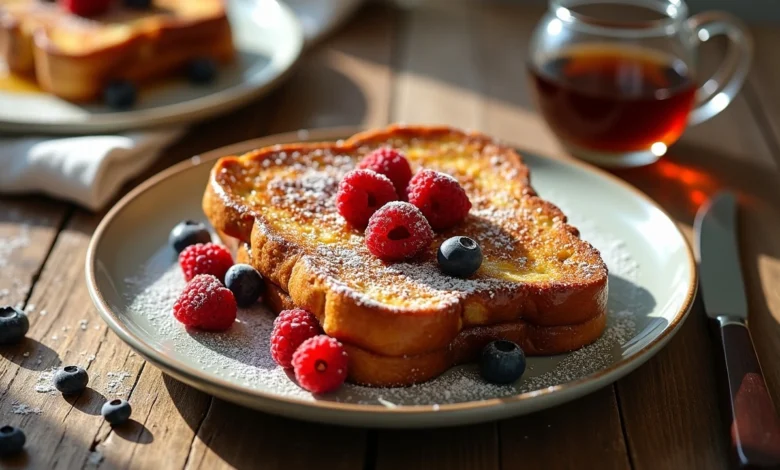
French Toast: 5 Easy Steps to a Perfect Heathy Breakfast
French Toast History
Are you tired of bland, soggy French toast that leaves you disappointed? We’ve all been there – standing over the stove wondering why our breakfast doesn’t look like those perfect golden slices in food magazines. The good news? Creating delicious, healthy French toast doesn’t require culinary school training.
This simple French toast recipe transforms basic ingredients into a breakfast masterpiece that’s both nutritious and satisfying. As a professional chef who’s spent years perfecting breakfast classics, I’ve distilled the French toast process into just 5 foolproof steps that guarantee perfect results every time.
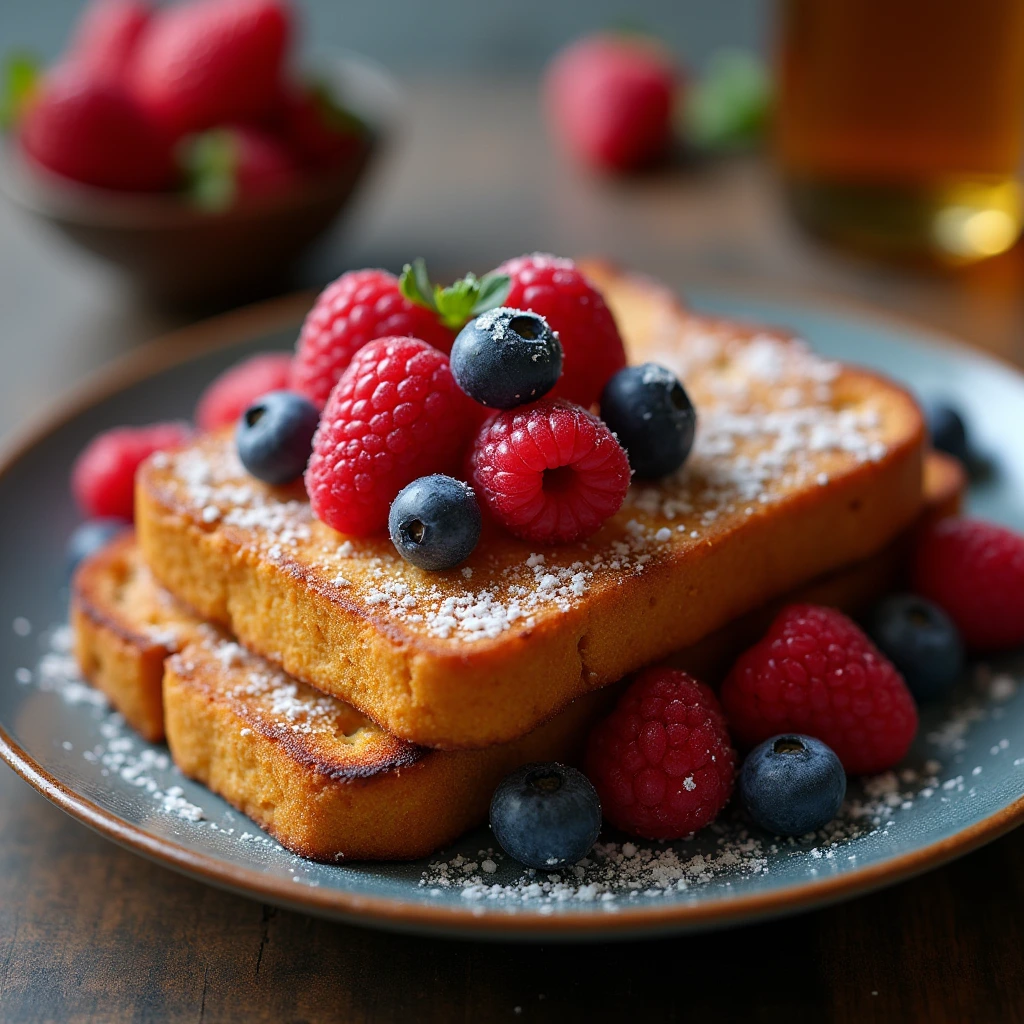
In this comprehensive guide, you’ll discover everything from selecting the right bread to mastering the perfect egg mixture. I’ll also share my pro tips for achieving that perfectly crisp exterior while maintaining a soft, custardy center. Plus, you’ll find creative variations to suit dietary preferences and flavor cravings.
Table of Contents
Why This French Toast Recipe Works
- Uses common pantry staples you likely already have
- Requires just 5 simple steps anyone can follow
- Incorporates healthy ingredients for a nutritious breakfast
- Perfect for busy mornings or leisurely weekend brunches
- Customizable to suit various dietary needs and preferences
French toast (or “pain perdu” as it’s known in France) dates back to ancient Roman times, when it was created as a clever way to use stale bread. The tradition of soaking bread in eggs and milk before frying has persisted for centuries because it’s simply delicious. Our modern version maintains this time-tested technique while incorporating healthier ingredients for a balanced breakfast.
Choosing the Right Bread
Best Breads for French Toast
The foundation of exceptional French toast is the bread itself. While you can use almost any bread, some varieties yield superior results:
- Challah or Brioche: The gold standard for French toast thanks to their rich, buttery flavor and sturdy texture that absorbs the egg mixture without falling apart.
- Whole Grain Bread: For a healthier option that adds fiber and nutrients while maintaining structure.
- Sourdough: Offers a tangy contrast to the sweet toppings and resists sogginess.
- French Baguette: Creates a crispy exterior with a soft interior when sliced into 1-inch rounds.
Bread Preparation Tips
- Day-old bread works best: Slightly stale bread absorbs the egg mixture without becoming mushy.
- Slice thickness matters: Aim for ¾-inch to 1-inch slices for the perfect balance of crisp exterior and soft interior.
- Allow time to dry: If using fresh bread, toast it lightly or leave slices out for 1-2 hours before preparation.
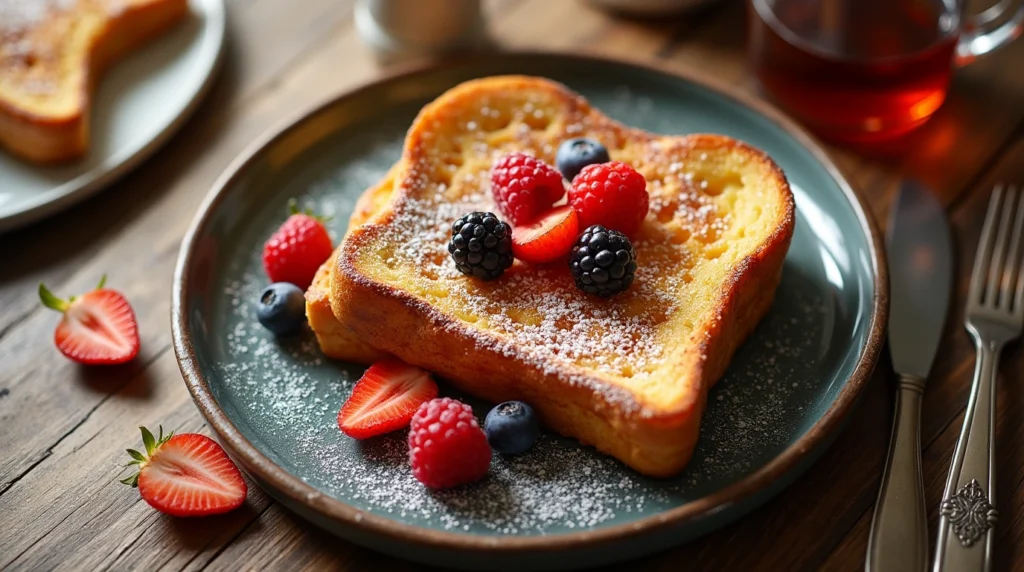
Substitutions
- Gluten-free bread: Choose denser varieties that won’t fall apart when soaked.
- Low-carb options: Keto-friendly breads can work but may require less soaking time.
- Dairy-free alternatives: Plant-based breads without added eggs work well with our vegan variation.
Ingredients Table & Prep
Ingredients
| Ingredient | Amount | Notes |
|---|---|---|
| Whole grain bread | 8 slices | Day-old preferred |
| Eggs | 4 large | Room temperature |
| Milk | 1 cup | Whole or plant-based |
| Vanilla extract | 1 teaspoon | Pure, not imitation |
| Cinnamon | 1 teaspoon | Ground |
| Nutmeg | ¼ teaspoon | Freshly grated if possible |
| Honey or maple syrup | 1 tablespoon | Plus more for serving |
| Salt | Pinch | Enhances flavor |
| Butter or coconut oil | 2 tablespoons | For cooking |
| Fresh berries | 1 cup | For serving |
| Greek yogurt | ½ cup | For serving |
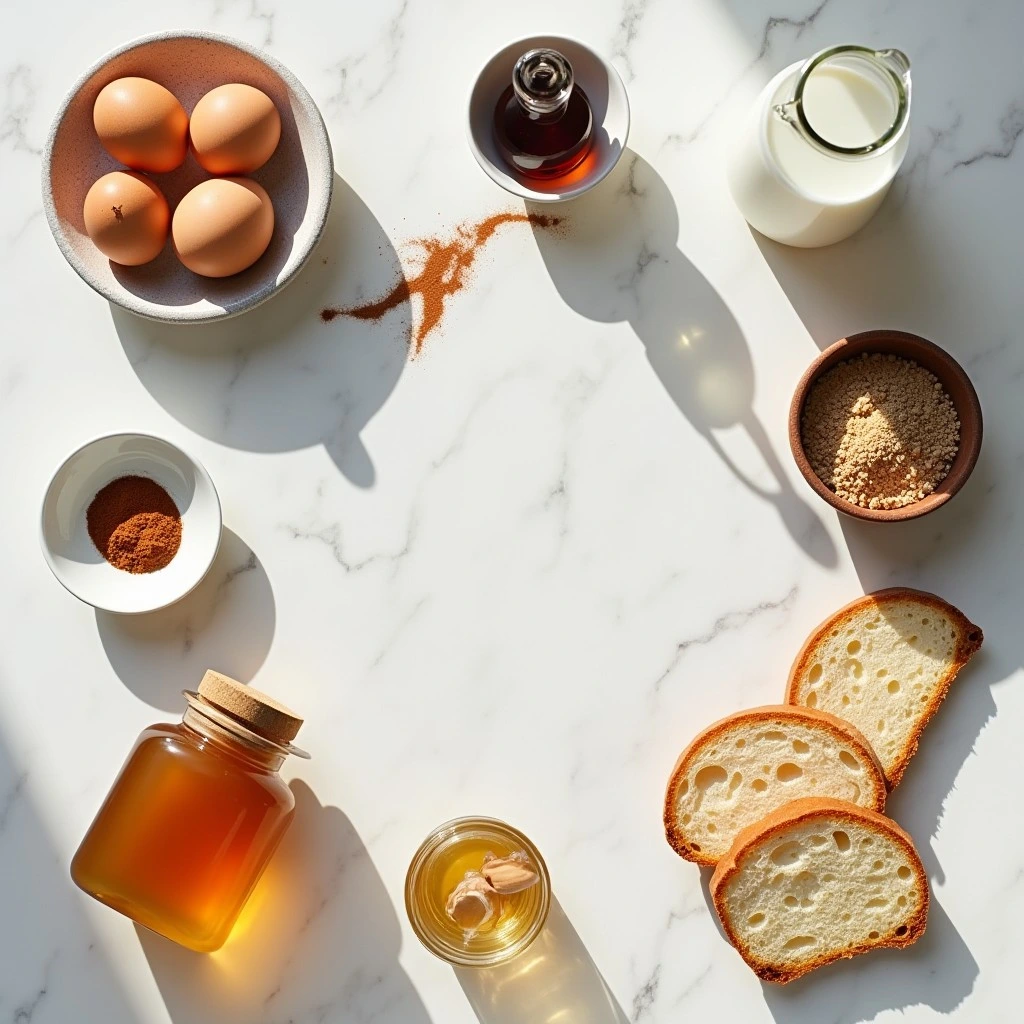
Egg Mixture Essentials
The perfect egg mixture is the secret to flavorful French toast. Whisk eggs until completely blended before adding other ingredients. This ensures even distribution of flavors and creates a smooth custard that coats the bread evenly.
Flavor Enhancers
- Vanilla extract: Adds depth and warmth to the flavor profile.
- Cinnamon and nutmeg: Classic spices that complement the eggy richness.
- Honey or maple syrup: A touch of sweetness in the batter enhances caramelization.
- Orange or lemon zest: Optional but adds a bright, citrusy note.
Healthy Swaps
- Replace whole milk with almond milk or oat milk
- Use coconut oil instead of butter for dairy-free preparation
- Substitute monk fruit sweetener or stevia for traditional sweeteners
Equipment (Amazon Link)
Having the right tools makes creating perfect French toast much easier. Here’s what you’ll need:
- Wide, shallow bowl: For the egg mixture, allowing easy dipping of bread slices
- Whisk: To thoroughly blend the egg mixture ingredients
- Non-stick skillet or griddle: Provides even heating and prevents sticking
- Spatula: For flipping without breaking the bread
- Measuring cups and spoons: For accurate ingredient proportions
- Plate lined with paper towels: To absorb excess oil after cooking
- Cooking thermometer: Optional but helpful for maintaining optimal cooking temperature
For best results, use a heavy-bottomed pan that distributes heat evenly. A cast-iron skillet works wonderfully but requires proper seasoning to prevent sticking.
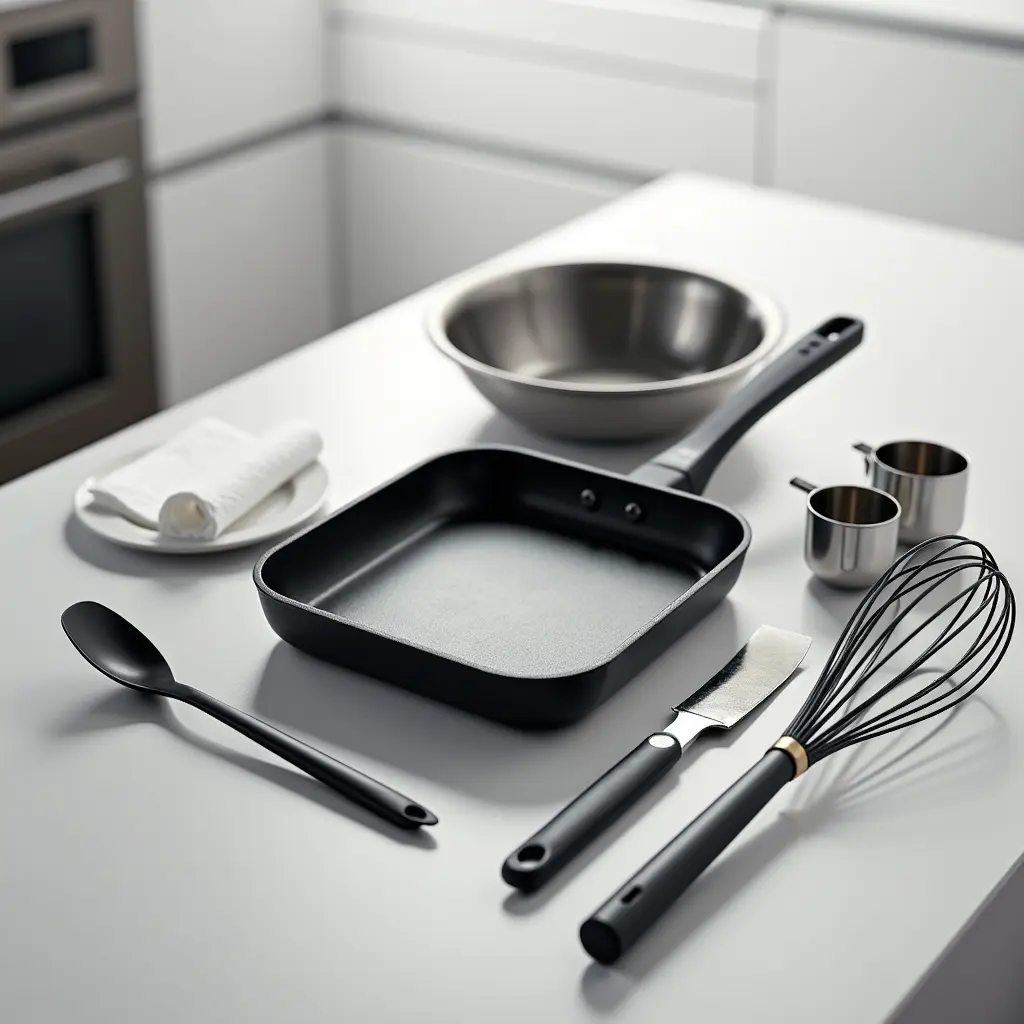
Step-by-Step Cooking Instructions
Pre-Cooking Prep
- Prepare the egg mixture: In a wide, shallow bowl, whisk together eggs, milk, vanilla, cinnamon, nutmeg, sweetener, and salt until well combined.
- Set up your station: Arrange your bread slices, egg mixture, and cooking surface in sequence for efficient workflow.
- Preheat your pan: Heat skillet over medium heat and add a small amount of butter or coconut oil.
Cooking Method
- STEP 1: Dip the bread Quickly dip each bread slice in the egg mixture, turning to coat both sides evenly. Allow excess to drip off. Don’t soak too long – 10-15 seconds per side is ideal for whole grain bread.
- STEP 2: Cook to golden perfection Place the soaked bread in the preheated skillet and cook for 2-3 minutes per side until golden brown and crispy on the edges. Work in batches to avoid overcrowding.
- STEP 3: Check for doneness The French toast should be golden brown on both sides and slightly puffed. The center should feel firm but springy when lightly pressed.
- STEP 4: Keep warm Transfer cooked slices to a baking sheet in a 200°F oven to keep warm while you finish cooking the remaining slices.
- STEP 5: Serve immediately Plate your French toast with your choice of healthy toppings like fresh berries, Greek yogurt, a light drizzle of maple syrup, or a sprinkle of cinnamon.
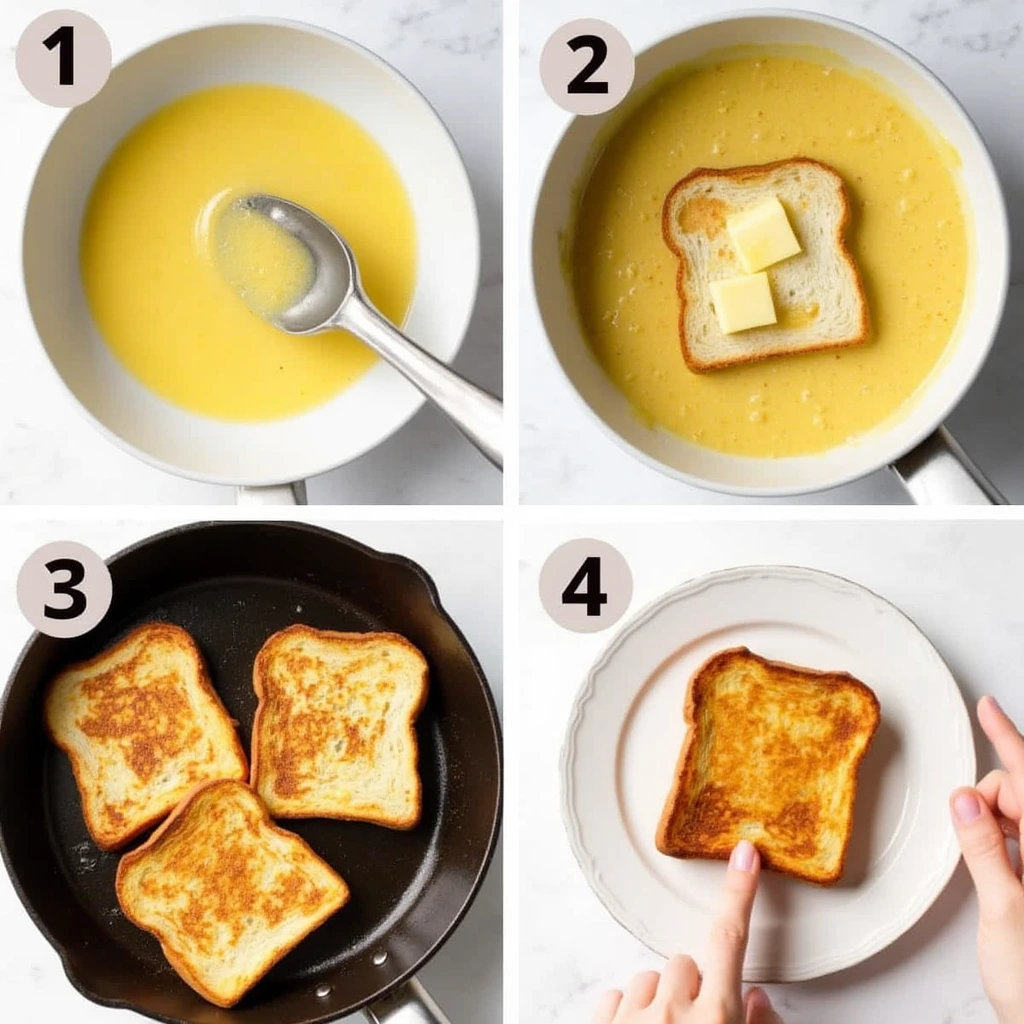
Doneness Check
Perfect French toast should have:
- A golden-brown exterior
- A slightly crisp edge
- A soft, custardy interior
- No raw egg taste or sogginess
Resting
Allow the French toast to rest for 1-2 minutes before serving. This brief rest allows the custard to set slightly and ensures the perfect texture.
Nutrition Table
| Nutrient | Amount per Serving | % Daily Value |
|---|---|---|
| Calories | 285 | |
| Protein | 12g | 24% |
| Carbohydrates | 35g | 12% |
| Fiber | 4g | 16% |
| Sugar | 9g | 10% |
| Fat | 11g | 17% |
| Saturated Fat | 4g | 20% |
| Cholesterol | 190mg | 63% |
| Sodium | 380mg | 16% |
| Calcium | 150mg | 15% |
| Iron | 2mg | 11% |
Nutrition values based on two slices of whole grain French toast with 1 tablespoon maple syrup and ¼ cup berries.
Pro Tips for Perfect French Toast
Avoiding Soggy French Toast
- Don’t soak the bread too long: 10-15 seconds per side is plenty for most breads.
- Use medium heat: Too high will burn the outside while leaving the inside raw; too low creates soggy results.
- Check your bread type: Denser breads need more soaking time, while softer breads need less.
- Maintain proper pan temperature: A drop of water should sizzle when it hits the pan.
Tool Recommendations
- Instant-read thermometer: Ensures your pan maintains 350°F-375°F for optimal cooking.
- Wide silicone spatula: Provides better control when flipping delicate slices.
- Butter warmer: Keeps melted butter at the perfect temperature for cooking.
Storage & Reheating
- Refrigerate leftovers: Store in an airtight container for up to 2 days.
- Freeze for later: Place cooled slices with parchment paper between them in a freezer bag for up to 1 month.
- Reheat in toaster: The best way to restore crispness to leftover French toast.
- Avoid microwaving: It tends to make French toast rubbery and tough.
Flavor Variations
Spicy Twist
- Add ¼ teaspoon cayenne pepper to the egg mixture for a subtle heat
- Incorporate 1 teaspoon of chai spice blend for a warming flavor profile
- Drizzle with hot honey for a sweet-spicy combination
Keto/Paleo
- Use almond flour bread or coconut flour bread
- Substitute almond milk for regular milk
- Use monk fruit sweetener or stevia instead of honey
- Add extra egg for more protein
Global Flavors
- Mexican-inspired: Add cinnamon, vanilla, and a dash of cayenne with a chocolate drizzle
- French-inspired: Use orange zest and Grand Marnier (1 tablespoon) in the egg mixture
- Japanese-inspired: Add matcha powder (1 teaspoon) to the egg mixture and serve with red bean paste
Serving Suggestions
French toast is versatile enough to be paired with numerous complementary sides:
- Protein boosts: Serve alongside Greek yogurt, a small portion of turkey bacon, or nut butter
- Fresh fruits: Berries, sliced bananas, or sautéed apples make perfect toppings
- Healthy fats: Sprinkle with chopped nuts or seeds for added nutrition
- Beverages: Pair with freshly brewed coffee, herbal tea, or a fruit smoothie
For a complete breakfast spread, consider adding a side of scrambled eggs with vegetables or a small bowl of overnight oats to round out the meal.
FAQs
Can I prepare French toast the night before? Yes! You can prepare the egg mixture and store it in the refrigerator overnight. You can even dip the bread and arrange it on a baking sheet, cover with plastic wrap, and refrigerate for quick cooking in the morning.
How do I fix soggy French toast? If your French toast turns out soggy, place it in a 350°F oven for 5-10 minutes to dry out the excess moisture and crisp up the exterior.
Is French toast healthy? Our version is healthier than traditional recipes! By using whole grain bread, limiting added sugars, and incorporating fresh fruits, you’re getting fiber, protein, and essential nutrients with fewer empty calories.
Can I make French toast without eggs? Yes! Substitute the eggs with ¼ cup chickpea flour mixed with ½ cup water or use a commercial egg replacer. The texture will be slightly different but still delicious.
How do I make French toast for a crowd? Prepare the French toast as directed, then keep warm in a 200°F oven on a wire rack set over a baking sheet. This keeps the pieces from getting soggy while you finish cooking the entire batch.
Conclusion
With these 5 simple steps, you’ve mastered the art of making perfect, healthy French toast. This breakfast classic doesn’t have to be complicated or unhealthy to be delicious. By using quality ingredients, proper technique, and our pro tips, you’ll create a breakfast that’s both satisfying and nutritious.
Remember that practice makes perfect – don’t be discouraged if your first attempt isn’t magazine-worthy. Each time you make this recipe, you’ll learn something new about the process and improve your technique.






